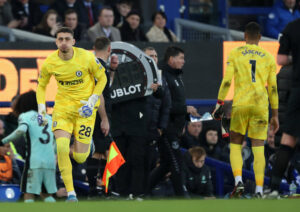The introduction of substitutions in England began in the 1960s when the Football League allowed just one replacement. Charlton Athletic winger Keith Peacock made history when he came on in a second division match at Burnden Park, Bolton in August 1965.
Peacock actually replaced an injured goalkeeper.
In the past, injured players, including goalkeepers, would usually be sent to hobble on the wing, despite their problems. The introduction of a substitute was a logical step.
Why Three Substitutions Are Enough in Modern-Day Football
High-Profile Injuries Prompted the Introduction of Substitutions
High-profile matches, especially FA Cup finals, had often been marred by injuries. Famous examples include Bert Trautman, who broke his neck in the 1955 final.
Manchester United goalkeeper Ray Wood suffered a broken cheekbone in a collision with Bolton’s centre-forward Peter McParland in 1957. And Roy Dwight (Uncle of Reg, aka Elton John) broke his leg after scoring for Nottingham Forest in the 1959 final.
A number of other players endured sometimes career-threatening injuries on that pristine Wembley surface. The high-profile nature of those incidents eventually contributed to the decision of the FA to allow changes.
Three Substitutions Became the Norm in the 1990s
This one-sub arrangement remained the same for the next 20 years. Its introduction gave coaches a new tactic. Then, by the mid-1990s, the nascent Premier League had increased the options to three substitutes.The use of 14 players from a pool of 16 now meant the game had definitely changed.
Coaches now had a wider variety of alterations to employ. Depending on the state of the contest. Although, it would benefit the better-resourced sides.
Concussion Substitutes Trialled
Subsequently, an addition to the process was the introduction of concussion replacements. This was something prompted by the long-running debate around head injuries in football. The option had already been a welcome feature of Rugby Union matches.
Not Always Good Viewing for Fans
Substitutes have certainly changed the nature of football both for the players and also for spectators. In May 2020, partly due to the Covid pandemic, the regulations allowed the use of five substitutes for top-level encounters. These included games in the Champions League. And the pressure grows to implement such a rule in the Premier League. Especially due to the present health-related circumstances and the possibilities of player burnout.
Again it would especially enhance the chances of the leading teams. While in the lower reaches of the national game it would make much less sense.Not least because some teams would struggle to field five subs.But another factor is the negative effect on those of us who watch. It inevitably means the length of a match is extended. Particularly given the other interruptions for injuries, referee lectures, and delaying tactics.
One extreme example was the 107th-minute winner scored by Algeria in the semi-final of the FIFA Arab Cup. Some 17 minutes of added time were played.
Fans also have to process the numerous variations and revised player positions. Often, as in many friendly internationals, the later stages are far less coherent. No wonder many leave early at Wembley matches. Substitutes were a welcome change but for many, there is a natural limit. Rugby Union has been described as a 23-man game. And let us not edge towards special teams for set-plays. Hopefully, football will avoid going down those routes. And those temporary issues will subside. Three substitutes are enough.
Main Photo






